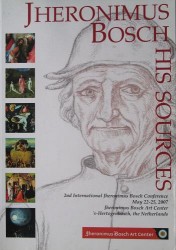
Pokorny 2010a
“Bosch and the Influence of Flemish Book Illumination” (Erwin Pokorny) 2010
[in: Eric De Bruyn / Jos Koldeweij (eds.), Jheronimus Bosch. His Sources. 2nd International Jheronimus Bosch Conference, May 22-25, 2007, Jheronimus Bosch Art Center, ’s-Hertogenbosch, the Netherlands. Jheronimus Bosch Art Center, ’s-Hertogenbosch, 2010, pp. 281-292]
That many of Bosch’s motifs are derived from Franco-Flemish book illumination is not a new insight at all. Thomas Kren even suggested that Bosch had access to the Burgundian/Habsburg court libraries. Pokorny agrees with this and tries to reveal some new indications in this field with the help of Bosch’s Garden of Earthly Delights. In Pokorny’s opinion on the central panel of this triptych Bosch depicted the earthly paradise which was sometimes mixed up with the heavenly paradise after the Last Judgment. We find an early example of this in a miniature by the so-called Master of Fitzwilliam 268 in the so-called Salting Hours (about 1470/80). [We suppose that what Pokorny is actually referring to here is the medieval concept of the Earthly Paradise as the last stage of Purgatory and as a waiting room for Heaven. According to Pokorny the Salting Hours miniature depicts a situation after the Last Judgment because we don’t see any souls ascending to Heaven, but surely according to medieval religious thinking after the Last Judgment there will be no Earthly Paradise anymore. Neither will there be a Purgatory anymore, as it will have lost its function.]
Apparently Bosch did not take that vision of paradise very seriously: he depicted his special paradise as an overcrowded world upside down, with giant birds and fruits and peaceful mermaids and sea knights. The idea of such a playing with relations and dimensions undoubtedly derives from the world upside down in the drolleries of illuminated books. The overkill of eating, playing and loving and the absence of angels suggest that a Cockaigne-like paradise was nonsense to Bosch and his employer, and maybe to all contemporary beholders as well. Following this concept Bosch melted incompatible parts of plants, shells, glass and gems to form unstable constructions. Some of these elements are intermingled with others akin to Late Gothic ornaments in the borders of illuminated books. Some manuscript miniatures with high horizon landscapes seem comparable to the composition and partition of Bosch’s overcrowded landscape on the central panel. Pokorny gives some further examples of similarities between Bosch’s central panel and miniatures. They concern i.a. a wild woman standing between giant strawberries, apes acting similarly to some of Bosch’s nudes, a wild man riding a griffin, a bear climbing up a tree. Most of Bosch’s animals are obviously copies, most likely from miniatures. Especially the art of Simon Marmion was presumably an important example for Bosch.
Drolleries with a sexual content were common in illuminated books, but their size and central placing in Bosch’s Garden are puzzling. Here they imply the special commission of a mighty patron. According to Pokorny this patron was not Henry III of Nassau but rather Engelbert II of Nassau because the old-fashioned style of the triptych argues for an early dating, as does the fact that Bosch quoted motifs from his Garden in his Adoration of the Magi triptych (Prado, recently dated between 1490 and 1498). As Engelbert was the most faithful ally of the Habsburg sovereigns he might even have arranged Bosch’s access to the Burgundian court libraries.
None of the examples from illuminated books given by Pokorny are convincing enough to conclude that Bosch was influenced by them. In all these cases we can at most speak of ‘parallels’ rather than ‘influences’, as is correctly done by Bernard Vermet in another contribution to the same book (p. 317, note 16).
[explicit 3rd August 2012]